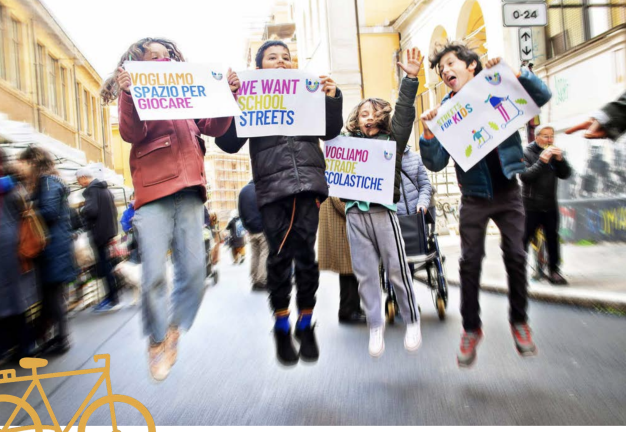
How to implement ‘School Streets’ safely in our cities
A leading cycling advocacy body has published guidance outlining some of the key benefits of ‘School Streets’ and how they can best be implemented on a global scale.
BYCS, an Amsterdam-based social enterprise which promotes cycling, has worked with the Clean Cities campaign to give a voice to those developing more child-friendly routes to school.
Their joint publication, School Streets to shape child-friendly cities, says school streets are fast emerging as a ‘low cost, simple intervention’ to reduce the use of motorised vehicles and pollution, while improving safety and encouraging walking and cycling.
This, they say, can ‘enhance community health and increased comfort among children and their families’.
“Their rapid adoption, mainly across European cities, can be linked to the need for safe social distancing near schools during the COVID-19 pandemic, but also as a response to crises of road safety, health and air quality, the growing child-friendly cities movement, as well as the acceptance of experimental or ephemeral approaches, such as tactical urbanism, open streets, slow streets and play streets,” it adds.
‘The growing child-friendly cities movement’
The report highlights a number of key findings, such as how school drop-offs represent a ‘significant’ share of motorised traffic. In London, for example, officials estimate that in 2018 around a quarter of weekday morning peak car trips were for school drop-offs – equating to some 254,000 trips per day.
Parents and children are also big supporters of School Streets, and the report points to a survey by children charity UNICEF in France, which found that 87 per cent of respondents were in favour of a school street being introduced around their child’s school. In the Canadian city of Toronto meanwhile, all children surveyed said they preferred their streets car-free, with around three-quarters believing that the street was unsafe before a successful pilot scheme was introduced.

Various case studies are highlighted, including London, Toronto and Tirana. Another notable success has been The Hague, in The Netherlands, a country known for its cycling infrastructure and where such initiatives have become ‘increasingly important’.
Only when you take the car away do people truly feel safe walking or cycling to school
“The local government in The Hague has notably been taking various measures to tackle traffic-related air pollution and road safety, such as low-emission zones and school zones,” says the report. “In 2019 the city organised its first School Street trial, and in only one year they succeeded in implementing 15 more.
Ronald Woudstra, the former director of Traffic Safety Capital Program in The Hague, is quoted in the report: “Only when you take the car out of the street do people truly feel safe when they are walking or cycling to school. In such a situation, more people will make the decision to walk or cycle to school instead of driving.”
The report concludes that school streets have had a ‘demonstrable impact’ across the world, and are emerging as a ‘new urban approach that could support healthier, safer, more sustainable and joyful cities for children, their families, as well as the broader population. Their simplicity, low cost, rapid implementation, high acceptance, and proven effects, indicates that transferability is high and that the likelihood of success in different urban contexts is strong’.
“Experiences from London, The Hague, Tirana and Toronto…show the different alternatives and good practices for a successful implementation of School Streets. Most are characterised by creativity, strong leadership and community involvement, often starting with a ‘pop-up phase’, before moving towards an interim phase and finally seeking permanence.”
‘Good practices for a successful implementation’
The report was produced by BYCS in collaboration with the Clean Cities Campaign, within the the framework of the Streets for Kids schools initiatives.
BYCS has also entered into a new partnership with the World Health Organisation (WHO) which is currently developing the Urban Health Strategic Guide. The aim is to make the case for a holistic approach to urban health, and provide guidance on how to put it into practice and support it for the long term.
BYCS says there is ‘strong evidence’ in the medical community supporting both the physical and mental health benefits of cycling, and is also an important way to curb air pollution and promote road safety, key issues in the realm of urban health.
“To this end, BYCS, in collaboration with the WHO, will conduct a series of participatory, policy-oriented consultations, facilitating the sharing of academic, practical, and experiential knowledge and building consensus toward the identification of key barriers and solutions to improving urban health. This will result in a set of concrete and actionable policy recommendations for national and city-level decision-makers,” it adds.




